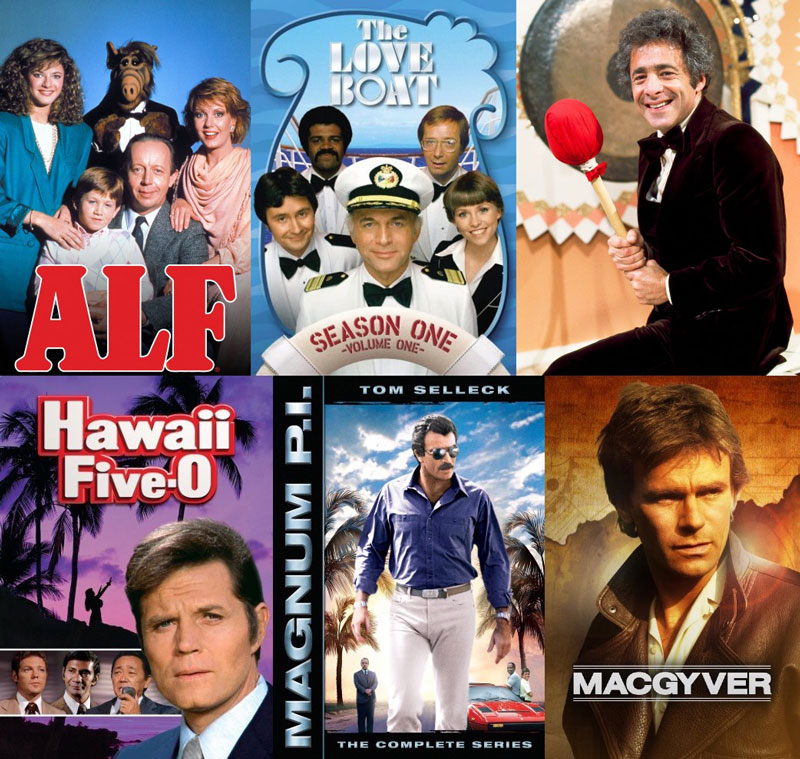A number of the TV executives contacted for this article didn’t want to comment publicly, but the general impression seems to be that most industry green-lighters want to keep their jobs and therefore refuse to take chances with anything new and unfamiliar.
While going through a list of recent reboots, remakes, spin-offs, and revivals, this reporter realized that just laying out those titles — and not even writing anything else — would take up more space than this entire story. Such is the state of the “retread” mentality that is evident throughout the U.S. TV landscape, and is (unfortunately) becoming the norm around the globe, too. With the exception of some non-U.S. shows (including, for instance, South Korea’s Squid Game), updated shows, spin-offs, remakes, and reimaginings, many of which use the titles of older, beloved shows (as the photo above indicates), inundate the TV landscape, prompting one to ask: “Why?”
Where has the originality gone? When seeking the answer, it quickly became evident that it isn’t due to a lack of creativity among the alleged creatives, as there are plenty of new ideas floating around in the ether. But because they are new, it seems that the green-lighting powers that be believe that audiences will steer clear of the unfamiliar, so they instead opt to stick with what they know, whether that be a recognizable title to use to lure in audiences, or an update of an old series. It can even be content taken from a popular, much-loved book series (George R.R. Martin’s 1996 Game of Thrones saga comes to mind). Still, in the majority of cases, these “revivals” haven’t lasted all that long.
While one might expect that it’s only the major U.S. networks guilty of this retreading, streamers have also been jumping onto the trend bandwagon, albeit in a much smaller way.
The situation isn’t just restricted to comedy or drama, but also happens with children’s shows, animated fare (for adults and children), and reality content. All have received the repurposed treatment of late. And this was very evident at a recent MIPCOM conference that promoted “new reality formats,” but went on to highlight old ones instead. It left the audience in the room disappointed.
It seems that once they reach a certain level, too many decision-makers are scared to put something new and original out there lest they lose their jobs. A survey could determine if this “fear of the new” can also be a consequence of the so-called “cancel culture.” Meanwhile, it is becoming abundantly clear that TV audiences are getting too many of these reboots, revivals, spin-offs, and blasts from the past, and would rather get new and innovative original content, instead.
This “fear of the new” could also be extended to talent agents, who are reluctant to take on new, unknown writers and/or directors without any prior screen credits.
Those in the streaming world can be a bit more “daring” because there is so much content available that they can afford to give something fresh and new a try. Additionally, they don’t have time slots or advertisers that they need to be concerned about.
Ian Katz oversees all editorial decision-making and commissioning as the chief content officer at Channel 4 in the U.K. A recent announcement that the BBC was programming Gladiators, a onetime hit ITV show from a few years back, prompted him to suggest that it was “depressing” how many old shows were coming back to screens and called it a “microwave moment” of “reheated old TV shows.”
Katz isn’t alone in such feelings, but not many others in the industry are as forthcoming. In fact, it’s rather difficult to get leading figures in the entertainment field to go public on the subject, even though those in the TV biz seem obsessed with recycling old TV shows.
But why is this happening? Audiences have not been demanding these returns, so why then is it happening? Is it the execs that are pushing to go with what they know to be safe?
Originality in program content seems to have taken a hit in recent times and, as noted earlier, it’s not for a lack of new ideas. There are so many new and good ideas out there, but they are not being picked up in favor of the oldies. There’s always been movement in the executive suite, but we’ve had a dizzying diet of exec musical chairs of late. So is this a case of green-light execs worried about their jobs if they say “yes” to something new that fails?
This problem also existed to a certain degree in the past, but in those days in order to try something new, at times, the decision-makers who commissioned the programming, especially at the TV station level, protected their jobs by hiring outside consultants who were paid to be willing to take the blame for shows if they failed.
According to Joanne Morreale, an associate professor of Media and Screen Studies at Boston’s Northeastern University, and author of several entertainment industry-related books, the reason is simple. “There is just so much TV out there,” she said. “Execs need content to fill the airwaves, so retreads are easy because they pull in older audiences who remember programs and they hopefully get new viewers, as well.”
Of course, even from the early days of TV, a copycat syndrome has been in play, according to Morreale. “Just about every live drama was an adaptation of a film or Broadway or radio play,” she said. “Even after there were original dramas, adaptations were common. The dramas even copied each other, so that a ‘teleplay’ that was successful on one program would often be replayed on a different program. Remakes are in TV’s DNA.”
While it’s difficult to argue with DNA, when TV was in its infancy, it didn’t offer the amount of content that is available today. Nor did it have the number of channels that we have today or a knowledge of what the viewing public might want to see. Everything was in the realm of the unknown.
The upside of these current revivals, suggests Morreale, is that they’re “a very low-risk proposition. If a show turns into a hit, they can always order another season.”
Today, one might expect that these shows are brought back to try and retain audiences and stop them from going to the streamers. Amazingly, streamers are taking the same tack — reviving cancelled shows — but not at the same percentage levels. Are they doing this only to add to their content lists?
The strange thing is that while reviving old shows can be perceived as going with something that audiences are familiar with, these “bring-backs” are happening with content for children who have no knowledge of the past. Sure, the parents could have something to do with it, but…
The amalgamation of so many entities into a single streaming service may eventually change the mindset. However, the fact that TV entities are now more “in bed” with film entities than ever before could very well be a reason both will continue going for the safe, familiar route, with the occasional foray into some “daring content.”
(By Mike Reynolds)
Audio Version (a DV Works service)












Leave A Comment